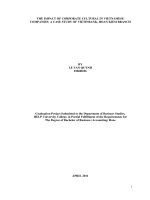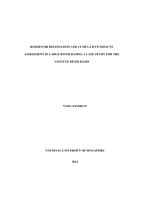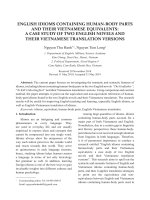the implementation and adopting of activity based costing in manufacturing vietnamese companies a case study of samsung vina corporation
Bạn đang xem bản rút gọn của tài liệu. Xem và tải ngay bản đầy đủ của tài liệu tại đây (430.85 KB, 64 trang )
THE IMPLEMENTATION AND ADOPTING OF ACTIVITY BASED COSTING
IN MANUFACTURING VIETNAMESE COMPANIES
A CASE STUDY OF SAMSUNG VINA CORPORATION
BY
TO THI THUY HA
Graduation Project Submitted to the Department of Business Studies,
HELP University College, in Partial Fulfillment of the Requirements for
the Degree of Bachelor of Business (Accounting) Hons
APRIL 2011
ii
Declaration of originality and word count
I hereby declare that the graduation project is based on my original work except for
quotations and citations which have been duly acknowledged. I also declare that it
has not been previously or concurrently submitted for any other course/degree at
HELP University College or other institutions. The word count is 10,346 words.
iii
Acknowledgement
I would like to express gratitude towards Dr. Pham Duc Hieu and Dr. Le Van Lien
and to Ms Suemathi for their support and guidance. I would also like to some my
friends for their financial support for this project.
iv
Abstract:
This paper aims to explore factors, which influence the process of activity-based
costing (ABC) implementation in the context of developing countries like Vietnam
where the challenging are much more than the opportunities, as well as analyze and
explain the changes in the area of methodology and organization of a company, after
activity-based costing implementation. The research findings are of both theoretical
and practical importance. From the practical point of view, companies considering
implementation of ABC should be aware of the positive and negative factors
conditioning the process of implementation; in addition, they should be familiar with
methodological and organizational changes, which might stem from the ABC
implementation, according the case of previous companies had project in
implementation it in all over the world to get the solutions for each challenging or
difficulty. From the theoretical point of view, this research might be helpful in
determining a more general tendency: although modifications in cost accounting
systems and implementation of modern methods of management accounting in
manufacturing Vietnamese companies come later than in more developed economies,
the tendency heads in the same direction.
v
Table of content
Page
Declaration of originality and word count ii
Acknowledgement iii
Abstract: iv
Table of content v
List of Figures vii
CHAPTER 1: INTRODUTION 1
1.1 Introduction 2
1.2 The objectives of research: 3
1.3 Problem statements: 5
1.4 The presentation: 6
CHAPTER 2: LITERATURE REVIEW 7
2.1 Historical development: 8
2.2 Definition and key concepts: 10
2.2.1 Definition: 10
2.2.2 Keys concept: 11
2.3 Implementing of ABC 13
2.4 The critical factors for successfully applying the ABC 17
2.5 The ABC‟s criticisms and limitation 20
2.6 The comparison between ABC and traditional costing system 22
2.6.1 Costing system 22
2.6.2 Traditional costing system 22
2.6.3 ABC versus Traditional costing 23
vi
CHAPTER 3: METHODOLOGY 28
3.1 Conceptual framework 29
3.1.1 Contingency theory 29
3.1.2 Shield‟s model 31
3.2 Qualitative case study design 33
3.3 Data collection 35
3.4 Data analyze 37
CHAPTER 4: ANALYZE 39
4.1 Samsung Vina Corporation Ltd (Savina) 40
4.1.1 The background of Savina 40
4.1.2 The technology industry 40
4.1.3 Estimating the accounting system of Savina 41
4.1.4 The ABC method in the context of Savina 42
4.1.5 The factors influencing ABC implementation 44
4.2 The factors influencing the implementation ABC in Vietnam 46
CHAPTER 5: CONCLUSIONS AND RECOMMENDATIONS 49
5.1 Conclusions 50
5.2 Recommendations 53
REFERENCE: 54
vii
List of Figures
Figure 1: Implementing of ABC 13
Figure 2: Theoritical research framework 31
1
CHAPTER 1: INTRODUTION
1.1 Introduction
1.2 The objectives of the research
1.3 Problem statements
1.4 The presentation
2
1.1 Introduction
In today‟s advanced manufacturing and competitive environment, accurate costing
information is vital for all businesses, like manufacturing businesses, service
businesses, and merchandizing businesses. In the past, companies supposed that,
customers who buy the high volume of products, and loyal customers are
profitability. The researches of profitability indicate that this view of companies is
not completely right. Innovations in producing and communication technologies
have changed the ways businesses conduct their activities extremely. The major
changes in the manufacturing cost structure which have led instructors and doctors to
argue that the traditional costing methods are no longer sufficient traditional volume-
based cost model to new costing methods such as Activity Based Costing (ABC) [2]
because of the implementing the advance in manufacturing technologies like robots
and computerized. ABC is a technique for developing cost estimates in which the
project is subdivided into discrete, quantifiable activities or a work unit. The activity
must be definable where productivity can be measured in units. After the project is
broken into its activities, a cost estimate is prepared for each activity. These
individual cost estimates will contain all labor, materials, equipment, and
subcontracting costs, including overhead, for each activity. Each complete individual
estimate is added to the others to obtain an overall estimate. Contingency and
escalation can be calculated for each activity or after all the activities have been
summed.
3
1.2 The objectives of research:
Costing is one of the most important factors that affect directly to the profitability,
assets, existence, and development of the company, so management accounting is
play an important role in the performance of the company. Activity Based Costing is
a powerful tool, and it is used by many big companies in all over the world. For
example, Ford Motor Company in historical, the view of focusing on the value
creation processes more than assets and organization. But facing with the
dramatically development of the others manufactures, especially Toyota Motor
Corporation, and realize of the impractical of exist accounting system, Ford decided
using the new one. After, researching and developing ABC system, positive
changing in productivity are improved like it can identify inefficient product,
allocation more profitability on the resources, reduce unnecessary cost. However, the
suggestions of most of firms are experiencing difficulties in implementing ABC and,
in some extreme cases, ABC implementation is not successful [3], these suggestions
are inherence by the mounting of evidences, in highly developed countries in the first
decade of the 21st century revealed that the number of companies using ABC ceased
to grow and stopped at an average, lower than anticipated, level [4]. Moreover, the
number of companies planning or considering the implementation of ABC dropped;
simultaneously, the number of companies, which quit implementation after analyzing
costs and benefits, rose. With the developing countries like Vietnam, management
accounting has been developed recent year, but there are not enough conditions for
the implementing ABC because the using of ABC run the risks of spending too much
effort, time, and money.
This research aims to discuss the applicable uses of ABC. The discussion is about
whether the use of Activity-Based Costing has an effect on firm‟s performance, and
4
how a company can adopt the ABC in its accounting system. The objectives of
research are to analyses the opportunities and threats when using ABC in Vietnam,
therefore, the companies can minimizing the risk for themselves by solving the
problems based on the theory of this method. The failure of using this method of
some companies will be considered avoiding the material mistakes when
managements make the decisions.
5
1.3 Problem statements:
Although there are many advantages of ABC method, but it cannot actually be
applied by all the companies. The limitation of ABC is that while it institutes a
complex methodology to assign costs to activities, the system remains far from
perfect. Some overhead costs such as the CEO's salary remains difficulty to separate
and allocate on a unit of product. Added value to product is not needed for all the
productions. For instance, an employee taking part in a first aid consciousness
campaign or a fire safety drill indulges in a productive activity, but the added values
are not calculated to the end product or service by these activities. Most ABC
methods allocate such 'business sustaining' costs to products on a proportionate basis
or based on assumptions, and this makes the system far from perfect. Thereby, before
changing to this method, company need to analyze their ability, benefits – costing.
The factors of the economy, sociality, and environment are also need to be
considered. So the problem statements of the paper are:
1, How is Activity Based Costing applied in the company?
2, What are the effect on performance of Activity Based Costing of
company?
3, What are the factors influencing the Activity Based Costing success?
This paper will answer above questions to orient for the companies which want to
adoption or implementation Activity Based Costing method.
6
1.4 The presentation:
This research is divided to five chapters, each chapter has own responsibility.
Chapter one briefly will talk about the aim of study, chapter two will about the
general view of Activity Based Costing, the traditional costing system and the
comparison between two these methods to helping for the analyzing the adoption of
ABC, chapter three will orient for the research by theories and models, how the data
can be collected and analyzed, the result of the above data, information will be
conducted in chapter four, it also supported by the case study, and the last chapter
will summarized the main ideas of the research and the recommendations are
possible for the implementing ABC‟s conditions in Vietnam – developing country.
7
CHAPTER 2: LITERATURE REVIEW
2.1 Historical development
2.2 Definition and key concepts
2.3 Implementation of ABC
2.4 The critical factors for successfully applying the ABC
2.5 The ABC’s criticisms and limitation
2.6 The comparison between ABC and traditional costing system
8
2.1 Historical development:
Traditionally, cost accountants had arbitrarily added a broad percentage of expenses
into the indirect costs, in addition, activities include actions that are performed both
by people and machine. However, the incorrect of this technique is gradually rose
with the using of indirect costs and overhead costs increasingly, because indirect
costs were not caused equally by all products. For example, one product may take
time in one expensive machine more than another product, but the costs of direct
labors and materials may be same in the manufacturing these products, additional
cost for use of the machine is not being recognized when the same broad 'on-cost'
percentage is added to all products. Consequently, when multiple products share
common costs, there is a danger of one product subsidizing another. ABC is based on
George Staubus' Activity Costing and Input-Output Accounting [5], the
manufacturing sector of the United States during the 1970s and 1980s, the concept of
ABC was started to perform. During this time, the Consortium for Advanced
Management-International provided a formative role for studying and formalizing
the principles that have become more formally known as Activity-Based Costing [6].
Robin Cooper and Robert S. Kaplan, advocates of the Balanced Scorecard, brought
notice to these concepts in a number of articles published in Harvard Business
Review beginning in 1988. According to Cooper and Kaplan ABC is an approach
which could solve some disadvantages of traditional costing systems, the actual costs
of production and of the costs of related services was calculated inaccuracy by the
costing systems. This led to the decisions making based on the inaccuracy
information of managers was also increased.
ABC investigates cause and effect relationships to objectively allocate costs as the
alternative of using wide-ranging arbitrary percentages to allocate costs. After
9
identifying the costs of activities, the cost of each is attributed to each product to the
extent that the product uses the activity. By this way, ABC often classifies areas of
high overhead costs per unit and then constitutes the solving by decreased the costs
or replaced costly produts. Activity-based costing was first obviously defined in
1987 by Robert S. Kaplan and W. Bruns as a chapter in their book Accounting and
Management: A Field Study Perspective [7]. They originally focused on areas of
advanced technology and productivity improvements, especially in manufacturing
industry, where have reduced the relative proportion of the direct labor costs and
materials, but have increased relative proportion of indirect costs. For example,
direct costs were decreased such as direct labor hours, but indirect costs were
increased such as depreciations, maintenance cost by the increasingly using
automatic systems. Cross-product, cross-customer subsidies are also occurred in
manufacturing industry because managements diverse their products and customers
to reduce financial risk. Since private expenses such as withdrawals of directors
represent the largest single component of non-interest expense in financial
institutions, the accurately allocation in products and customers of these costs must
be took more care. Although activity based costing initially developed for
manufacturing industries, it may even be a more useful tool for doing this [8]. Then,
in 1999 Activity Based Costing were explained more details by Peter F. Drucker in
the book Management Challenges of the 21st Century [9]. He states that traditional
cost accounting focuses on what it costs to do something, in contracts, ABC also
records the costs of doing nothing, for example, to cut a screw thread; activity-based
costing records the cost of not doing, such as the cost of waiting for a needed part,
but traditional costing system ignores it.
10
2.2 Definition and key concepts:
2.2.1 Definition:
There are many factors affect to the capacity of the manufacturing potentially,
Activity Based Costing is designed to provide managements the accurate information
of costs for finding strategies and making decisions. ABC is a subset of activity-
based management, which is used to identifying and evaluating activities of the
firm‟s performance.
In companies with multi goods and services for customers, the absolutely accurate
costing information is vital factor in determine whether the profitability products or
they are making loss. Activity Based Costing is most appropriate method for these
companies, but the effort required to successfully implement ABC is spending the
time and resources. ABC can identify high overhead costs per unit and having the
solving to reduce the costs, avoiding inaccurate allocation of costs, and measurement
profitability with higher accuracy than traditional that uses direct-labor hours as the
only cost driver. ABC works firstly with identifying the main activities of process.
Next to allocate the groups of activities together the cost pools are created. Following
this cost drivers is identified. After that, rates are calculated. Which are then applied
to the respective cost drivers for each product or service that is being considered.
Lastly, originating the overhead cost per unit by dividing the total costs of products
to the numbers in unit of products.
11
2.2.2 Keys concept:
There are some concepts will be used in this research, to having more clearly view,
this part‟s talk is to explain these concepts such as cost pools, cost driver, direct and
indirect costs. The cost pool is the term of accounting, it can be defined as the groups
of accounts serving to express the cost of goods and service locatable within a
manufacturing organization. The volume of cost pools are different from this
organization to others, for example, there may be hundreds of employee in the cost
pool for order processing of big companies, whereas there may not have a separate
cost pool for this activity in small companies, because this activity only related to
one or two employees. There are some costs too minor or difficult to allocated, they
may not be included in any cost pool.
Each activity cost pool has relevant cost drivers which are used in allocating cost.
Cost driver is defined as any activity that makes the cost incurred. A business
occupies in many different activities. The cost driver is the factor that influences the
amount of the resources that will be spent by a specific activity. The cost driver is
use to determine the activity of the work that is already done, the resource is what the
activity uses to do the work, i.e., people, equipment, services, it is important because
resources always are expensive.
ABC method is related to the indirect cost of the activities, which cannot accountable
for the cost objects. Indirect costs may include taxes, administrations, personal,
contingent and security costs, it can be known as overhead costs. In contrast,
traditional costing system focus on the direct costs, which directly relate to the
products, it includes direct labors, direct materials, direct expenses. Indirect costs are
those for activities that benefit more than one project, because the exact benefits of
12
specific project are really difficult to determine, for example, evaluation of the
activities of directors of business to the result of projects is impossible. Whereas,
direct costs are those for the activities that benefit particular project, for example, the
salaries for project managers.
13
2.3 Implementing of ABC
The companies will find implementing ABC – a powerful tool in measuring
operating of the company, they want to be successful in implementing this method,
there are several steps must be taken which are summary in below figure.
Figure 1: Implementing of ABC
1, The study processes and costs – the first step in implementing Activity
Based Costing is a research for all the aspects of business processing. Employee
involvement is main factor to make the system perform effectively and efficiently,
thus before the accounting system‟s results are relied truly by the employees at all
levels, these results are needed to believe by employees.
2, Identify activities – After understanding about the process of implementing
ABC, selecting the business activities must be paid attention of the business, these
activities will be center to the allocated costs. There will be many the system
14
activities become uncontrollable, too few that leads to no meaning of information. If
activities are classified at different levels, it can supply better results: unit – level
activities which are those activities and a unit of output that have a one-to-one
correspondence with each other, for example, in each final product of a camera
manufacturing had to checked before packaging, thus, checking may be seen as an
activity, batch – level activities which are those activities relate to one or more units
of product, but they still must be performed. Example of shipping could be
considered as the outstanding of this level, in eBay – one of the biggest online shops,
some customers order only one good while others may order more than five at a
time, the packing and shipping of ordered goods require the same activities no matter
of how many goods are put in a box, product – level activities which are run at the
product level whatever the size of production. Product marketing, product design,
which are considered as activities and the amount of the finished good have one – to
– one correspondence, there are many forms of customer – level activities, catalogs,
lines, sales calls, and so on are helped by the technique in customer – level activities.
The investigation and finding the activities is unique to each company. A frame of
reference is provided by the above levels to help the organizations estimate what
activities are more important for performance of manufacturing. Experts who
expertize in ABC can also be very helpful in training a company as it searches for its
important activities that will become center to an ABC method. Generally, these
experts advise the following, first every conceivable activity should be listed, second
the activities according level should be segregated, and the last is similar activities
should be combined logically within each level.
3, Identify traceable costs – When a cost occurring that evolving to the
particular cost object, that cost should be traced directly to the end of object, the
15
common example of this is the direct labor and direct material, these costs usually do
to the end of object, there are some other examples for the clearing, there are
spending many hours of indirect labors, these costs later would be calculated to the
activity cost pool, besides that that costs also relate to the printers so that cost could
be traced to the "customer" cost object.
4, Assign remaining cost to activities - After classifying the costs that can be
traced to cost objects, the others are allocated to activities, this work sometimes is
logical and easy but sometimes difficult, for examples, there are some manufactures
in industrial engineers that their productivity processes are automatic, the workings
are based on the set up of the machine, the machine set-up activity is the activity that
the cost of setup is assigned to, a variety of final goods will reallocated this activity.
However, in industrial engineers the cleaning up after each machine setup will be
required because of the massive and complexity of this industry.
The considering of what activity will engage cost and what cost object shall cost
ultimately be attributed are important for management. The allocated cost decisions
are controversial even though that there are some, therefore, some costs will be not
allocated by ABC, but that does not mean this system ignore to allocate these costs.
For the purpose of identifying particular product‟s cost or other cost object, the
leaving of unallocated cost of ABC is logical, but it would be reckless to forget about
these unallocated costs, the management of organization must recover all of them. To
recover the unallocated and allocated cost, the prices must be limited.
5, Determine per-activities allocations rate – When the total costs for each
activity have been measured, then the identifying the cost pools are necessary, for
16
example, the preparation of products‟ catalog activity cost pool costs $400,000 and
400,000 catalogs were printed, hence the allocated catalog cost would be $1.00 each.
6, Apply costs objects – to calculate the number of activity cost to allocate to
each cost object, the using activity based rate is the final step. Following the above
example of catalog, the allocated cost from the catalog preparation pool was $1.00
each, this cost is not the total costs, but the allocated amount, the total cost would
also include the directly traceable amounts (printing, postage, etc.), the cost of
catalog, along with other customer-related costs would be compiled in some form of
summary report, managers then have a calculation of what the cost of supporting an
additional customer is.
17
2.4 The critical factors for successfully applying the ABC
This research will point out some factors that Vietnamese companies should consider
when having the project on implementing ABC. The factors that will be considered
include the developing of non-interest expenses‟ management accounting policies
and standards, picking a suitable and appropriate ABC methodology, identifying the
scope of the project accurately, choosing the fitting ABC application, assembling and
training teams that have responsibility of ABC in company, and developing and
sustaining the ABC database.
The first factor is the developing of policies and standards involve to the non –
interest expenses‟ management accounting. How non – interest expenses in the
business is treated make the affirmation of the creation of costing consistently
throughout the institution. When implementing an ABC method to get a more profit
objective, the enhancing of management accounting policies and standards
commands how assets, liabilities, revenues and expenses are treated in the
profitability system. The buy – in across the organization will be created by the
establishing the policies and standards at the high level of management. The
committee for the policies will be a factor for success of ABC approach.
The second factor is the choosing the right methodology of ABC. The activity level
costs and non-interest expenses of processing center to each activity are related to
each other. To distribute these non - interest expenses, the need of a selecting the
suitable method is critical, cost information is tied to business events directly as a
result for managements‟ usage. When the costs are linked to the business activities
and changes in size, the relationship between costing information and profitability is
immediately set. Hence, management will embrace the reliability of the information.
18
The third is the determining the scope of Activity Based Costing project, which is
vary because it is depend on the size of financial department. The estimating the
duration of project requires the accuracy because the need for setting the
expectations. After the duration of the ABC project is predicted, the note for the
leverage existing unit cost data should be considered.
The selecting an ABC application is important because all the objectives and
requirements ABC approach will be meet. The flexibility to create and build unit
costs for both qualitative resource groups and for processing resource groups should
be allowed by the ABC application. The survey in web-based which are functionality
for units and positions also should incorporated by the application.
Then the factor of assembling and training ABC team is analyzed because the size of
this team depends on the expectation about ABC approach of the company. Initially,
team should be received the guidance and instructions from the ABC resource. The
transferring of this ABC knowledge should be quickly to develop team members into
contributors to ABC process.
The maintenance of ABC database is the last factor, which addresses that continuing
maintenance of the unit costs is required. The changing in center operating expenses
is reflected by the unit costs which are updated annually. New unit times must be
developed when having the new systems or the changes in the procedures the unit
times must be adjusted. The unit times still should be reviewed every several years
for the accuracy even though there are no changes in procedures or installing new
systems.
Understanding these above factors, the organization will have the full view of many
opportunities and the potential available in ABC method. When implementation the









